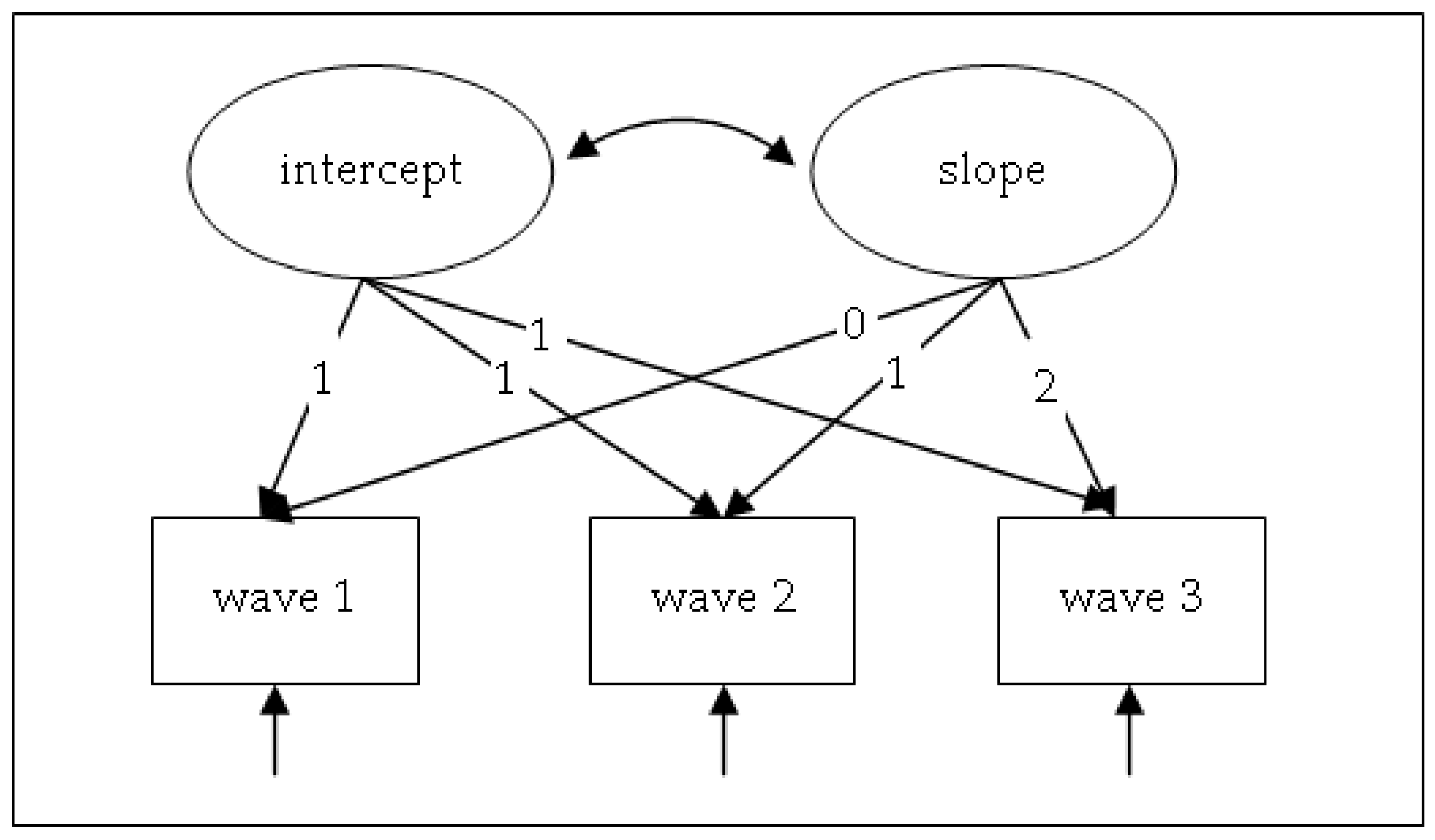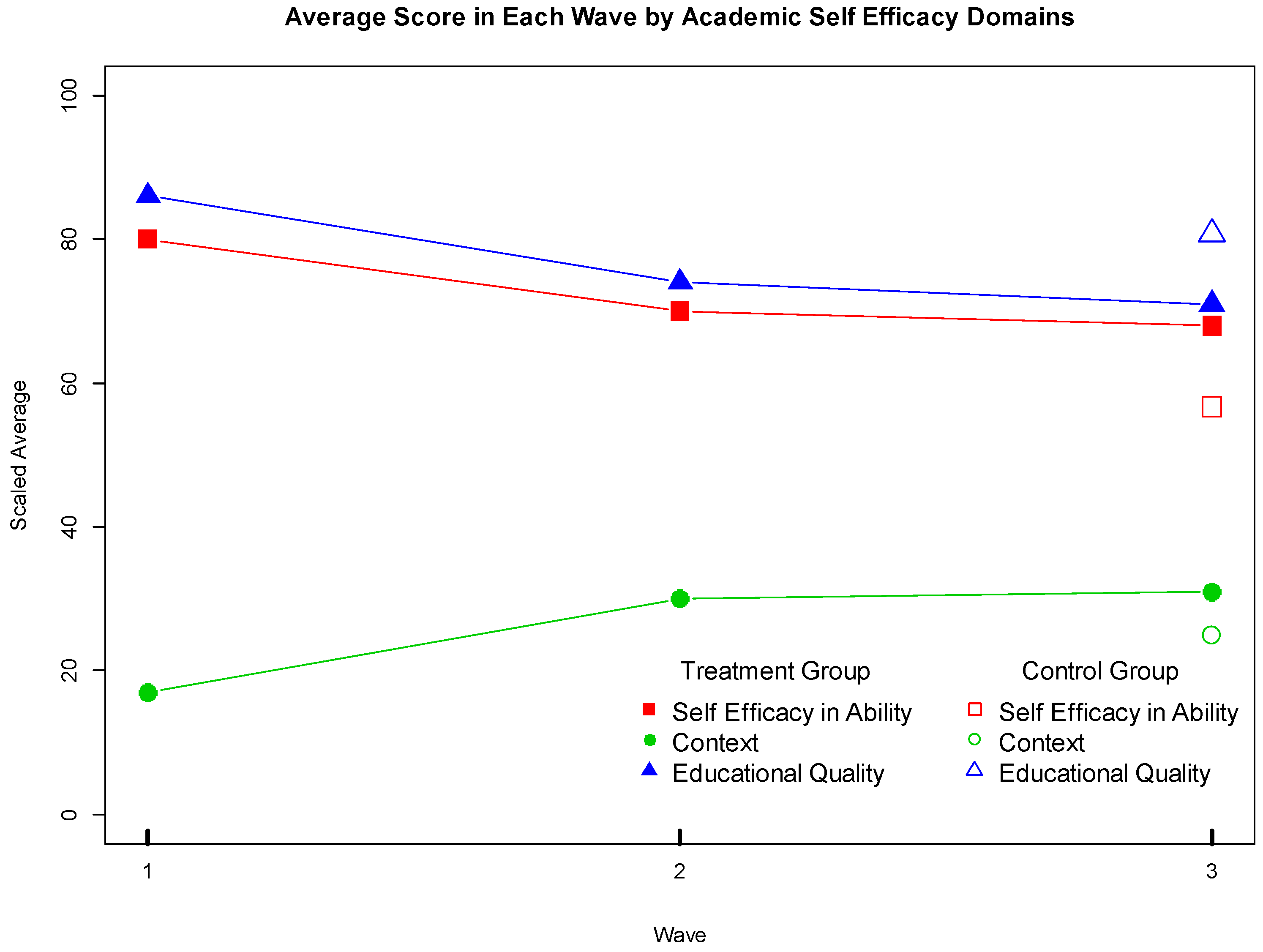Does Project Children’s University Increase Academic Self-Efficacy in 6th Graders? A Weak Experimental Design
Abstract
1. Introduction
- Academic self-efficacy is a judgment of an individual related to his/her ability to perform given actions and it is not a person’s physical, psychological, and personal characteristics.
- Academic self-efficacy belief is related to different fields and it is multidimensional. Therefore, the belief in language self-efficacy is different from the belief in mathematic self-efficacy.
- Academic self-efficacy measurements show contingency. For example, a student may be successful in a collaborative classroom environment, while he can have a lower achievement in a competitive classroom environment.
- When the level of academic self-efficacy is determined, the performance of the student is taken as the basis.
- What are the descriptive characteristics of treatment group students’ academic self-efficacy in three waves and control group students’ academic self-efficacy in wave 3?
- How do treatment group students’ academic self-efficacy levels vary across three waves?Null hypothesis: Treatment group students’ academic self-efficacy levels do not vary across three waves.
- What is the difference between the treatment and control group students’ academic self-efficacy levels in wave 3?Null hypothesis: There is no difference between the treatment and control group students’ academic self-efficacy levels in wave 3.
2. Materials and Methods
2.1. Sample
2.2. Project Children’s University
2.3. Data Collection Tool
2.4. Analytical Strategies
2.4.1. Missing Data
2.4.2. Reliability Analyses
2.4.3. Obtaining Scaled Domain Scores
2.4.4. Growth Curve Analyses
2.4.5. Comparison of Treatment vs. Control Groups
3. Results
3.1. Descriptive Properties of the Sample Regarding Academic Self Efficacy
3.2. Growth of Academic Self Efficacy Levels of Treatment Group Students
3.2.1. Growth Curve Analysis for the Self-Efficacy in Ability
3.2.2. Growth Curve Analysis for the Context
3.3. Comparison of Treatment and Control Group Students in Wave 3
3.3.1. Comparison of Treatment and Control Groups in Wave 3 for the Scaled Self-Efficacy in Ability Domain Scores
3.3.2. Comparison of Treatment and Control Groups in Wave 3 for the Scaled Context Domain Scores
4. Discussion
5. Conclusions
Author Contributions
Funding
Acknowledgments
Conflicts of Interest
References
- Chapin, F.S., III; Torn, M.S.; Tateno, M. Principles of Ecosystem Sustainability. Am. Nat. 1996, 148, 1016–1037. [Google Scholar] [CrossRef]
- Brundtland, G. The World Commission on Environment and Development. In Our Common Future; Brundtland, G., Ed.; Oxford University Press: Oxford, UK, 1987; pp. 45–65. [Google Scholar]
- Hargreaves, A.; Fink, D. The ripple effect. Educ. Leadersh. 2006, 63, 16–20. [Google Scholar]
- Suzuki, D. The Sacred Balance: Rediscovering Our Role in Nature; Greystone Books: Vancouver, BC, Canada, 1997. [Google Scholar]
- Dede, C. Comparing frameworks for 21st century skills. In 21st Century Skills: Rethinking How Students Learn; Solution Tree Press: Bloomington, IN, USA, 2010; Volume 20, pp. 51–76. [Google Scholar]
- Yurdakul, B. Eğitimde Yeni Yönelimler, 2nd ed.; Demirel, Ö., Ed.; Pegem A Yayıncılık: Ankara, Turkey, 2005. [Google Scholar]
- Bandura, A. Self-efficacy. In Encyclopedia of Human Behavior; Ramachaudran, S., Ed.; Academic Press: New York, NY, USA, 1994; pp. 71–81. [Google Scholar]
- Bandura, A. Self-Efficacy: The Exercise of Control; W. H. Freeman and Company: New York, NY, USA, 1997. [Google Scholar]
- Schunk, D.; Pajares, F. The Development of Academic Self-Efficacy. In Development of Achievement Motivation; Wigfield, A., Eccles, J., Eds.; Academic Press: San Diego, CA, USA, 2001. [Google Scholar]
- Maddux, J.E.; Gosselin, J.T. Self Efficacy. In Handbook of Self and Identity; Leary, L.M., Tangney, J.P., Eds.; Guilford Press: New York, NY, USA, 2003. [Google Scholar]
- Chun, A.H.C.; Choi, J.N. Rethinking procrastination: Positive effects of “active” procrastination behavior on attitudes and performance. J. Soc. Psychol. 2005, 145, 245–264. [Google Scholar] [CrossRef]
- Zimmerman, B.J. Self-efficacy: An essential motive to learn. Contemporary Educ. Psychol. 2000, 25, 82–91. [Google Scholar] [CrossRef] [PubMed]
- Schunk, D.H.; Mullen, C.A. Self- efficacy as an engaged learner. In Handbook of Research on Student Engagement; Christenson, S.L., Reschly, A.L., Wylie, C., Eds.; Springer: New York, NY, USA, 2012; pp. 219–235. [Google Scholar]
- Eccles, J.; Wigfield, A. Motivational Beliefs, Values and Goals. Annu. Rev. Psychol. 2002, 53, 109–132. [Google Scholar] [CrossRef] [PubMed]
- Zimmerman, B.J. Self-Efficacy and Educational Development. In Self Efficacy in Changing Societies; Bandura, A., Ed.; Cambridge University Press: New York, NY, USA, 1995. [Google Scholar]
- Pajares, F. Self-Efficacy Beliefs in Academic Settings. Rev. Educ. Res. 1996, 66, 543–578. [Google Scholar] [CrossRef]
- Yılmaz, M.; Gürçay, D.; Ekici, G. Adaptation of the academic self-efficacy scale to Turkish. Hacet. Univ. J. Educ. 2007, 33, 253–259. [Google Scholar]
- Aşkar, P.; Umay, A. Perceived computer self-efficacy of the students in the elementary mathematics teaching programme. Hacet. Univ. J. Educ. 2001, 21, 1–8. [Google Scholar]
- Ekici, G. The validity and reliability of the biology self-efficacy instrument. Hacet. Univ. J. Educ. 2005, 29, 85–94. [Google Scholar]
- Akbas, A.; Çelikkaleli, Ö. The Investigation of the Preservice Elementary Teachers’ Science Instruction Self-Efficacy Beliefs According to Their Gender, Type of Education, and Universities. Mersin Univ. J. Fac. Educ. 2006, 2, 98–110. [Google Scholar]
- Çetin, A.; Toytok, E.H. Children’s University in the Eyes of Students. In Proceedings of the 27th International Conference on Educational Sciences, Antalya, Turkey, 18–22 April 2018. [Google Scholar]
- Çetin, A.; Kahyaoğlu, M.; Erulaş, F.A. A project blended with science and art: Children university science activities. In The Most Recent Studies in Science and Art, 1st ed.; Arapgirlioğlu, H., Atık, A., Hızırlıoğlu, S., Elliott, L., Atik, D., Eds.; Gece Publisher: Ankara, Turkey, 2018; Volume 1, pp. 1522–1535. [Google Scholar]
- Jinks, J.; Morgan, V. Children’s perceived academic self-efficacy: An inventory scale. Clear. House 1999, 72, 224–230. [Google Scholar] [CrossRef]
- Öncü, H. Adaptation of Academic Self-Efficacy Scale into Turkish. Ahi Evran Univ. J. Educ. 2012, 13, 183–206. [Google Scholar]
- Buuren, S.; Groothuis-Oudshoorn, K. Mice: Multi variate Imputation by Chained Equations in R. J. Stat. Softw. 2011, 45, 1–67. [Google Scholar] [CrossRef]
- Core Team. R: A Language and Environment for Statistical Computing; R Foundation for Statistical Computing: Vienna, Austria, 2017; Available online: https://www.R-project.org/ (accessed on 17 June 2018).
- Rosseel, Y. lavaan: An R Package for Structural Equation Modeling. J. Stat. Softw. 2012, 48, 1–36. [Google Scholar] [CrossRef]
- Welch, B.L. The generalization of student’s’ problem when several different population variances are involved. Biometrika 1947, 34, 28–35. [Google Scholar] [CrossRef] [PubMed]
- Lv, B.; Zhou, H.; Liu, C.; Guo, X.; Zhang, C.; Liu, Z.; Luo, L. The relationship between mother–child discrepancies in educational aspirations and children’s academic achievement: The mediating role of children’s academic self-efficacy. Child. Youth Serv. Rev. 2018, 86, 296–301. [Google Scholar] [CrossRef]
- Honicke, T.; Broadbent, J. The influence of academic self-efficacy on academic performance: A systematic review. Educ. Res. Rev. 2016, 17, 63–84. [Google Scholar] [CrossRef]
- Sachitra, V.; Bandara, U. Measuring the Academic Self-Efficacy of Undergraduates: The Role of Gender and Academic Year Experience. Int. J. Soc. Behav. Educ. 2017, 11, 2443–2448. [Google Scholar]
- Bandura, A. Social cognitive theory: An agentic perspective. Asian J. Soc. Psychol. 1999, 2, 21–41. [Google Scholar] [CrossRef]
- Pajares, F. Current directions in self-efficacy research. In Advances in Motivation and Achievement; Maehr, M., Pintrich, P.R., Eds.; JAI Press: Greenwich, CT, USA, 1997. [Google Scholar]
- Schunk, D.H. Modeling and attributional effects on children’s achievement. A self-efficacy analysis. J. Educ. Educ. 1981, 73, 93–105. [Google Scholar] [CrossRef]
- Schunk, D.H. Effects of effort attributional feedback on children’s achievement: Self-efficacy analysis. J. Educ. Psychol. 1982, 74, 548–556. [Google Scholar] [CrossRef]
- Elias, S.M.; MacDonald, S. Using past performance, proxy efficacy, and academic self-efficacy to predict college performance. J. Appl. Soc. Psychol. 2007, 37, 2518–2531. [Google Scholar] [CrossRef]
- Medrano, L.A.; Flores-Kanter, E.; Moretti, L.; Pereno, G.L. Effects of induction of positive and negative emotional states on academic self-efficacy beliefs in college students. Psicol. Educ. 2016, 22, 135–141. [Google Scholar] [CrossRef]
- Olcum, D.; Titrek, O. The effect of school administrators’ decision-making styles on teacher job satisfaction. Procedia-Soc. Behav. Sci. 2015, 197, 1936–1946. [Google Scholar] [CrossRef]


| Group | Wave | Self-Efficacy in Ability | Context | Educational Quality |
|---|---|---|---|---|
| Treatment | 1 | 0.884 | 0.750 | 0.750 |
| Treatment | 2 | 0.938 | 0.866 | 0.798 |
| Treatment | 3 | 0.964 | 0.892 | 0.840 |
| Control | 3 | 0.882 | 0.736 | 0.471 |
| Self-Efficacy in Ability | Context | Educational Quality | |
|---|---|---|---|
| Treatment | |||
| Wave 1 | 80.352 (15.467) | 17.558 (16.561) | 86.743 (20.762) |
| Wave 2 | 70.692 (21.228) | 30.631 (23.690) | 74.872 (25.170) |
| Wave 3 | 68.262 (25.247) | 31.820 (25.603) | 71.434 (28.119) |
| Control | |||
| Wave 3 | 56.696 (20.276) | 24.906 (18.858) | 80.789 (19.508) 1 |
| Self-Efficacy in Ability | Context | |||||
|---|---|---|---|---|---|---|
| Regression Coefficients | ||||||
| Unstandardized | Standard Error | Standardized | Unstandardized | Standard Error | Standardized | |
| Intercept | 79.668 *** | 1.451 | 7.666 *** | 18.607 *** | 1.633 | 1.808 *** |
| Slope | −6.139 *** | 1.524 | −0.510 *** | 7.040 *** | 1.305 | 0.582 *** |
| Covariance | −33.122 | 42.983 | −0.261 | −23.146 | 48.302 | −0.116 |
| Variance Components | ||||||
| Unstandardized | Standard Error | Standardized | Unstandardized | Standard Error | Standardized | |
| Wave 1 | 181.579 *** | 70.481 | 1.120 *** | 216.588 * | 84.330 | 0.652 * |
| Wave 2 | 372.693 *** | 60.505 | 1.884 *** | 497.226 *** | 75.960 | 0.683 *** |
| Wave 3 | 229.889 *** | 114.416 | 2.107 *** | 186.138 | 129.807 | 0.230 |
| Intercept | 109.725 | 67.895 | 1.000 | 126.374 | 84.953 | 1.000 |
| Slope | 146.073 *** | 47.884 | 1.000 | 148.512 ** | 53.070 | 1.000 |
| Academic Self-Efficacy | t | df 1 | 95% Confidance Interval | Cohen’s d |
|---|---|---|---|---|
| Self-Efficacy in Ability | 4.155 *** | 151.104 | (6.067, 17.066) | 0.676 |
| Context | 2.465 * | 145.372 | (1.257, 12.458) | 0.409 |
© 2019 by the authors. Licensee MDPI, Basel, Switzerland. This article is an open access article distributed under the terms and conditions of the Creative Commons Attribution (CC BY) license (http://creativecommons.org/licenses/by/4.0/).
Share and Cite
Toytok, E.H.; Gürel, S. Does Project Children’s University Increase Academic Self-Efficacy in 6th Graders? A Weak Experimental Design. Sustainability 2019, 11, 778. https://doi.org/10.3390/su11030778
Toytok EH, Gürel S. Does Project Children’s University Increase Academic Self-Efficacy in 6th Graders? A Weak Experimental Design. Sustainability. 2019; 11(3):778. https://doi.org/10.3390/su11030778
Chicago/Turabian StyleToytok, Esef Hakan, and Sungur Gürel. 2019. "Does Project Children’s University Increase Academic Self-Efficacy in 6th Graders? A Weak Experimental Design" Sustainability 11, no. 3: 778. https://doi.org/10.3390/su11030778
APA StyleToytok, E. H., & Gürel, S. (2019). Does Project Children’s University Increase Academic Self-Efficacy in 6th Graders? A Weak Experimental Design. Sustainability, 11(3), 778. https://doi.org/10.3390/su11030778





